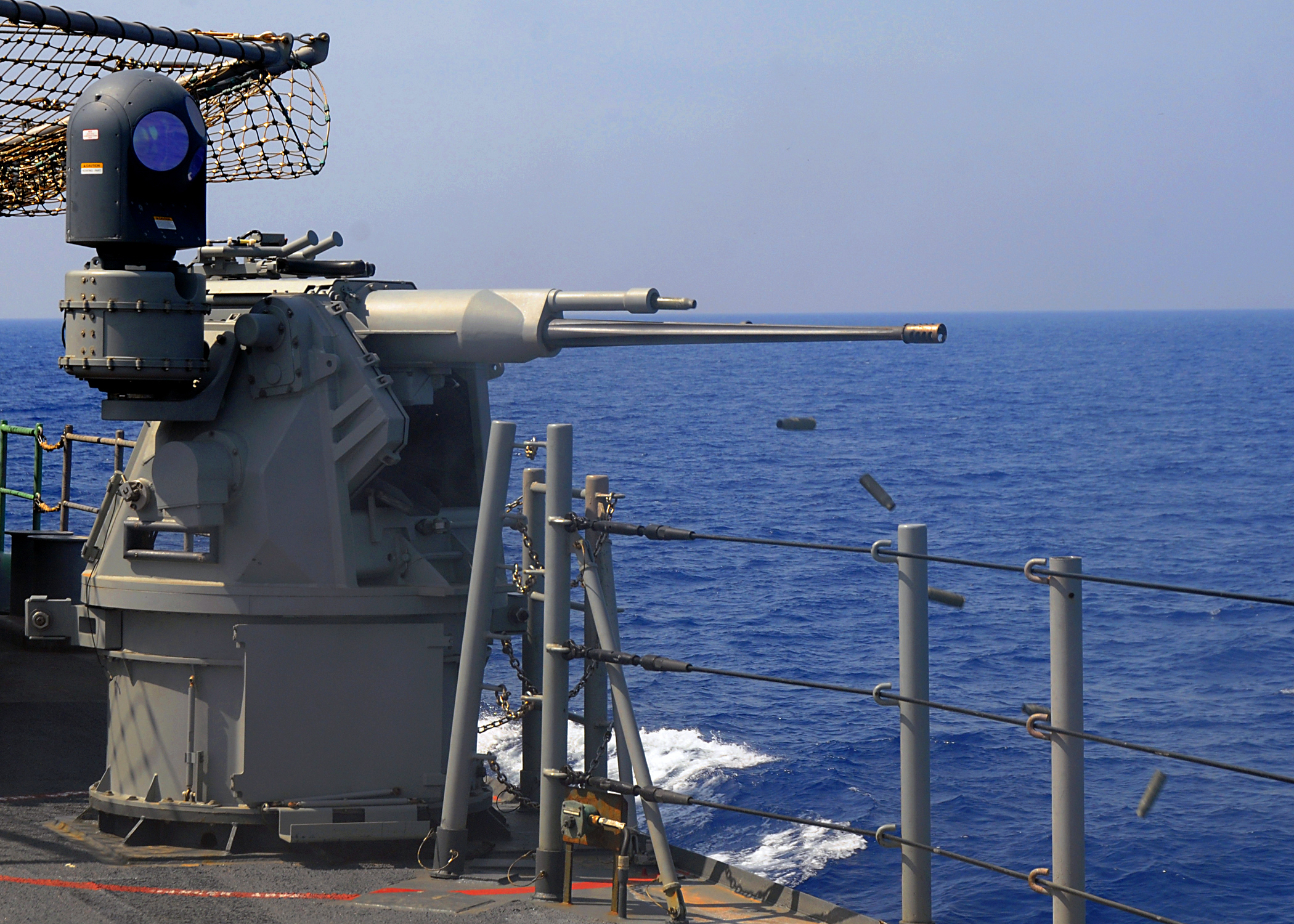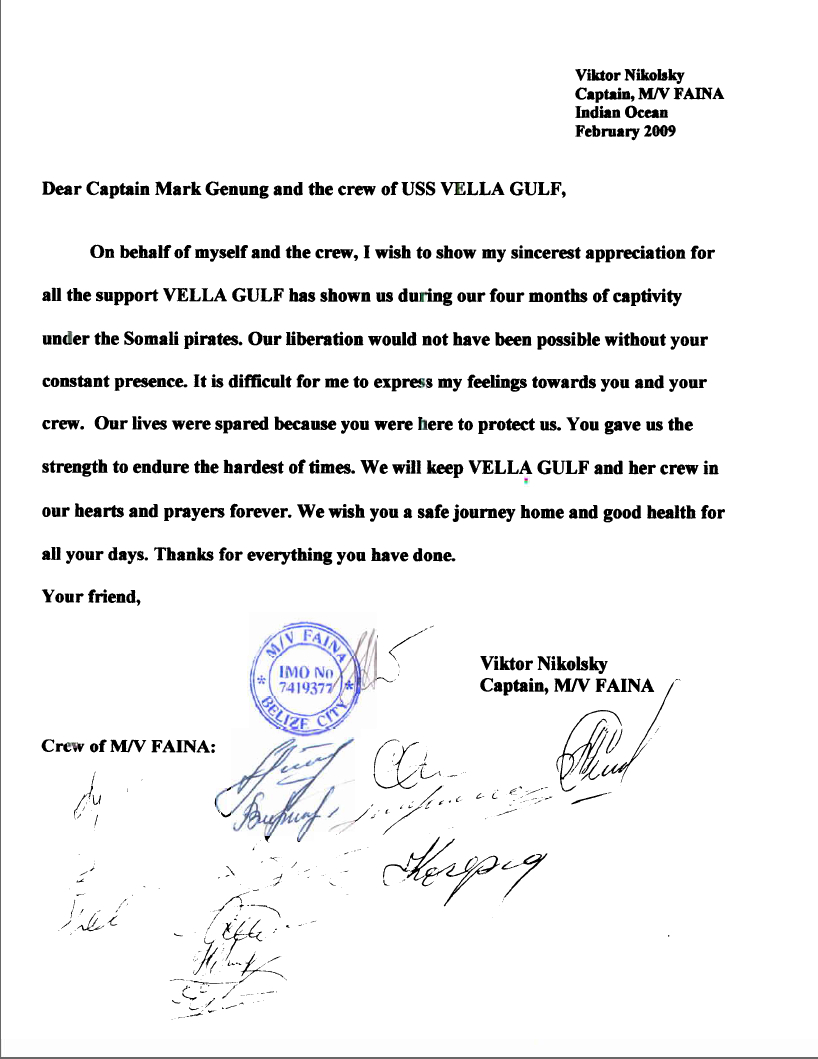Now that the USN has successfully rescued Captain Phillips and eliminated or captured all four pirates, we should be using the increased public awareness of the piracy problem to improve our anti-piracy policy. A few remarks:
Implications of Somali Piracy1. Piracy in and of itself represents a threat to the economic interests of the United States. In addition to shipping companies paying out ransoms, insurance rates are going through the roof, and in some cases shipments are being re-routed, making the voyages longer and more expensive. Quite simply, piracy is an intolerable drain on commerce.
2. Although it is my opinion that the Somali piracy is organized crime, not terrorism, the success of the pirates thus far highlights weaknesses of the sort that terrorists can exploit. We should anticipate that terrorists will hijack vessels in the future, but with much more sinister intentions than holding the ship and crew for ransom. Possible terrorist missions could include threatening execution of hostages in exchange for political demands being met, causing a massive oil spill, sinking a ship in a narrow channel to block it, exploding a liquefied natural gas carrier, or attempting to collide with other vessels. It should therefore be a high priority to develop effective anti-hijacking tactics, as well as deploying technologies appropriate to this mission.
3. The limitations of the USN in dealing with piracy was demonstrated by this situation and others. Pirates are well-aware that they can succeed provided they are able to stay in possession of the captured ship and crew, allowing them to get to land.
4. The lethal violence used by the French Navy and USN may have second-order effects. On one hand, it may deter pirates into finding another line of work (this would surely happen if enough pirates met their demise that they could could count on being killed or captured). On the other hand, the pirates
have already vowed revenge against US and French mariners. The gauntlet has been thrown, and over the short term, we should be prepared for an escalation of violence against US and French targets.
Developing Anti-Piracy Policies1. Current ROE: CTF-151 will come to the aid of ships in distress and attempt to capture pirates caught in the act. This represents an evolution from previous ROE where pursuit was not authorized. Captured pirates are usually handed over to Somali authorities in Puntland, or to Kenya.
2. I agree with other commenters that the protection of US-flagged ships should be a priority for the US Navy. I am all in favor of our warships continuing to act to protect international trade in general, but, when a US-flagged ship is transiting this area, US assets should be allocated to them first, and to other traffic second. The vow of the pirates to take revenge upon US mariners should underscore this imperitive.
3. Merchant ships are generally unamred. This is not due to any international law prohibiting the carrying of arms, but rather because of legal difficulties that would arise in various destination ports. The use of small/mounted arms has been successful in preventing successful boardings, as the attempted attacks against the USNS John Lenthal and a German supply ship. The pirates use small, open skiffs to approach their targets, often having to chase them and overtake them slowly. They are relatively easy targets and will usually turn and run if fired upon. The lack of defensive arms on merchant ships is one of the principal factors enabling piracy, and is likely the lowest-cost solution (not considering legal difficulties or increases in insurance rates---i.e. legal BS).
In my opinion, arming merchant crews is a no-brainer. Unfortunately, foreign laws will likely make that impossible, and little can be done about that. It is a shame, because the purpose of law is to protect the lives and rights of people, and to facilitate efficient business. In the case of piracy, these laws are making people vulnerable while making business more difficult. These laws ought to be changed, but there is no way to "reach into" the domestic sphere of foreign states to change these laws.
Perhaps, alternatives could be considered. For example, private security firms could embark teams on merchants at one side of the transit, and disembark them on the other side. Cost, of course, would be a major factor, because this would require substantial logistical support. Another option may be to embark a small craft on which the weapons could be disembarked when the merchant makes a port call. The downside of this would be that some crew would not be available for loading/unloading operations while they "babysit" the weapons.
4. The current "area patrol" defensive tactics are clearly inadequate to deal with piracy. More effective tactics are needed. However, it must also be observed that the area is simply too large and too populated to completely lock down with any defensive tactics. Our goal should not be to stop every instance of piracy, but to deter it. Deterence will be acheived by killing and capturing enough pirates that the risk is not something that can be ignored. Therefore, our defensive tactics should be oriented towards apprehending as many pirates as possible.
5. Rather than responding to distress calls as the primary means of attempting to prevent hijackings/capture pirates, I propose a more pro-active approach. Merchant traffic should be corralled into designated corridors, chosen for their distance from heavily-fished areas. This should not be terribly difficult, because they already more or less use known shipping lanes. Those lanes might just need to be moved a little. CTF-151 and other anti-piracy vessels will then actively scout those sea lanes. Using ISR assets such as P-3 Orions, UAVs, and shipborne helicopters, vessels in those lanes should be identified. Those craft will then be subject to search, prior to the merchants arriving. If any craft is found with weapons, or especially ladders and grappling hooks, the occupants would be arrested. The motherships and skiffs should be seized, and, after checking to make sure any motherships aren't themselved captured craft, burned.
This approach poses two problems: logistical and legal. Legally, a navy cannot board a ship without consent, unless that ship flies the flag of its navy or is inside the territorial waters of that navy. So, a UN Security Council resolution will be necessary to carry out this strategy. Although, frankly, I think we'd be better off carrying out the boardings anyways. The consequences for illegally boarding some fishing boats is far less than the cost of allowing hijackings to continue.
Second, there is the logistical problem of getting out the boarding teams to the site. It will not be possible to saturate the sea lanes such that all potential pirate craft can be searched. But this is no reason not to do it. CTF-151 ships should patrol in the designated lanes, casting dragnet as they go, sprinting from craft to craft and sending out RHIBs to inspect them. Additionally, helicopter carriers like the Boxer can be used to transport small boats and crews greater distances than can be done with a frigate or destroyer. US ships should prioritize sanitizing the area ahead of US-flagged merchants.
Going forward, the DoD should take note of the kinds of platforms that are useful for sanitizing these sea lanes. As remarked earlier, we may need to develop these operations for counterterrorism at some point, as well as maritime security operations, or perhaps even protecting an amphibious operation from irregular or hybrid warfare. The more boarding teams and helicopters, and the better protected our people are, the better. And all the antiship missiles in the world aren't as useful as a well-trained sniper team.
6. A legal framework for trying pirates needs to be developed. Is this something the ICC could handle? The best option would be an international tribunal of some sort. Alternatively, I don't see any reason why Congress couldn't amend our own
antipiracy statute to confer universal jurisdiction to the Federal courts as against pirates (edit: it would appear that the statute as written already does confer universal jurisdiction). I'd also be in favor of nonjudicial punishment at sea of pirates, but somehow I doubt that would happen in this day an age.
What not to doWhile an ultimate solution to piracy must be on land, now is not the time to carpet-bomb Eyl or anything else we're hearing from the hawks along those lines. One thing to consider is that the pirates currently hold more than 200 hostages. There would also be a lot of collateral damage, which is bad enough on its own, but in addition, laying waste to pirate strongholds would have the 3rd-order effect of strengthening the fundamentalist terrorist insurgents to the south, possibly allowing them to sieze control of Somalia. A more responsible approach would involve an all-out nation building strategy, which no one has the resources or the stomach to follow through on.
I think our best bet is to reduce piracy through deterrence, and that the pirates will then turn to other ways to eke out a living, such as fishing and trade. If that transition is gradual, then soft-power techniques might be useful in slowly civilizing the area.












